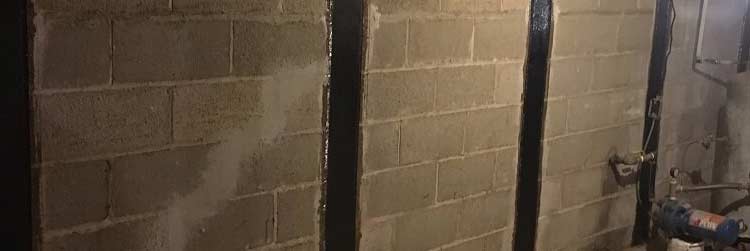Block Foundation Problems (and Their Solutions)

There are many homes throughout Hamilton and Burlington that have block foundations. Cement block foundations are excellent for supporting a heavy vertical load, but unfortunately, they don’t do nearly as well when there is a horizontal load pushing against these blocks.
Because many homes with cement block foundations used to be built without reinforcement, they are susceptible to movement. This means certain problems can occur which may require block foundation repair.
The following is a list of some of the most common cement block foundation problems that we see in Hamilton and Burlington homes:
- Bowed foundation walls
Usually, this happens when there is very wet clay soil surrounding the foundation. The clay soil exerts too much pressure against the block foundation and walls will begin to bow inward. It is important to catch and repair this kind of problem early. At Conterra Foundation, we recommend reinforcing these bowed walls to prevent further bowing.
- Sheared foundation walls
A sheared foundation wall is when the second row of blocks begins to edge over the first row of blocks. If you notice this starting to happen (and it can be by as little as an eighth of an inch), it means the exterior soil is moving the blocks. In this scenario, you will need a structural engineer to make sure that too much damage hasn’t been done. As long as the damage is minimal, we will be able to begin a foundation repair, which will require some excavation around the exterior of the home.
- Pushed in foundation wall
Occasionally in Hamilton or Burlington, we see a situation where the block foundation has not been adequately anchored to the sill plate. When this happens, the top of the foundation is gradually pushed inward. When we see this, the repair process is similar to that of when there is a sheared foundation wall.
- Shifted or cracked foundation blocks
When single concrete blocks have moved or cracked, it is often because of some outside pressure against them, such as tree roots. When this happens, we must dig up the exterior to expose the foundation and then remove and replace the affected blocks.
- Degraded mortar joints
Homes that were built around the 1940s often have mortar that is not as strong as the mortar that is used today. If you live in an area with clay soil or poor grading, over time, this can cause the mortar joints to begin to disintegrate. When this happens, the best course of action is usually to remove the affected part of the foundation and rebuild it.
- Stair step cracks
If you notice stair-step cracks in your foundation, it is because moisture is getting through and following the mortar joints between the cement blocks. A combination of moisture and temperature variances is causing the cracks. To correct this problem, we usually recommend supporting the foundation with piering and adding some waterproofing.
If you have a home in the Burlington or Hamilton area and are experiencing any of these block foundation problems, contact Conterra Foundation today to schedule a meeting.